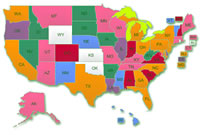Fixed Versus Adjustable Rate Mortgages
A big dilemma is whether to choose a fixed-rate mortgage or an adjustable-rate mortgage (ARM). With a fixed-rate mortgage, your monthly payment is set at the beginning and will never change. If you opt for an adjustable-rate loan, your initial interest rate may be lower, but the interest rate and monthly payment can climb quickly as interest rates rise.
If current rates are low, or if you expect to stay in your new home for at least five years, a fixed-rate mortgage is probably your best bet. But if rates are high, an ARM may tide you over until rates decline and you can lock in a fixed rate.
If you’re planning to sell the house in less than five years, you may choose an adjustable mortgage with a lower initial interest rate. Do this only if that rate is 2 to 3 percent lower than current fixed rates, and there is no charge for repaying the loan early-called a prepayment penalty.
If you decide on an ARM, you need to know not only the initial rate, but on what basis it will be adjusted and how often. Each lender may impose a different cap-that is, a ceiling above which rates cannot rise. Generally, your interest rate shouldn’t increase more than 2 percent at any one time, or 6 percent for the life of the loan. Also, make sure you’ll be able to meet the higher monthly payments as they occur.
You might also consider a hybrid mortgage, with a fixed rate for a few years, and adjustable after that. The mortgage payment is calculated over 30 years, but is fixed for the first five years at a lower rate than a fixed 30-year mortgage. If you plan to stay in your home less than five years before moving on, the hybrid mortgage with a five-year fixed rate will guarantee you a stable mortgage payment while you are there.
Another option is to pay your loan off faster than the traditional 30-year mortgage. If you choose a 15-year mortgage, the interest rate may be somewhat less than a 30-year mortgage. In addition, the quicker you pay your loan, the less interest you will pay over the life of the loan. A $100,000 loan paid over 30 years at 7 percent will cost $139,400 in interest. (That means your $100,000 loan actually costs you $239,400.) Pay it off using a 15-year loan at 6.5 percent, and it costs $56,800 in interest. That’s a savings of $82,600 in interest-which isn’t chickenfeed!
If you decide to use an ARM, here are some important rules to keep in mind:
- Don’t choose a loan with rates that change more than once per year. You don’t want to get stuck in a cash flow crunch as your payment goes up month by month.
- Don’t choose a loan with rates that can go up by more than 2 percent per year. Two percent may sound small, but it can create a big increase in your monthly payment. Be sure you will have time to adjust.
- Choose a loan with rates that have an increase limit of no more than 6 percent over the life of the loan and no decrease limit. You don’t want to get stuck with a loan that will increase stratospherically. Conversely, you want to be able to take advantage of any interest rate decreases that might be in your future.
- Don’t use negative amortization. Negative amortization means that you are not fully paying off the interest on your loan-in other words, you are getting deeper into debt each month. You want to pay down your mortgage, not increase it!
- Use a slow-moving index. Check which index your proposed ARM is tied to. Choose an index that is not as reactive to a rise in interest rates, such as the bank’s cost of funds, instead of the Treasury index.
Be Aware of Closing Costs
Closing costs on your loan can add up to thousands of dollars. When you apply for a mortgage, your lender should provide a good faith estimate of these costs, including “points”, which are the lender’s one-time charge for transacting the loan. Each point represents 1 percent of the mortgage amount, and the more points you pay up front, the lower the interest rate for the life of the loan. If you plan to stay in your new home for several years, it’s to your advantage to pay an extra point up front to get an interest rate that is a quarter to a half percentage point lower. But if you plan to move after only a couple of years, paying extra points for a lower rate may not be wise.
Here’s a worksheet you can use to compute your effective interest rate if you pay points. Use this worksheet to compare the various options that are offered to you by the lender, and you will be able to determine whether paying points to reduce the interest rate is worth the up-front cost.
| Your Effective Interest Rate | |||
| Option #1 | Option #2 | Option #3 | |
| 1. Mortgage points (as a percentage) | |||
| 2. Years you plan to own your home | ÷ | ÷ | ÷ |
| 3. Annual cost of points | |||
| 4. Interest rate (the APR) | |||
| 5. Effective interest rate (line 3 + line 4) | ÷ | ÷ | ÷ |






